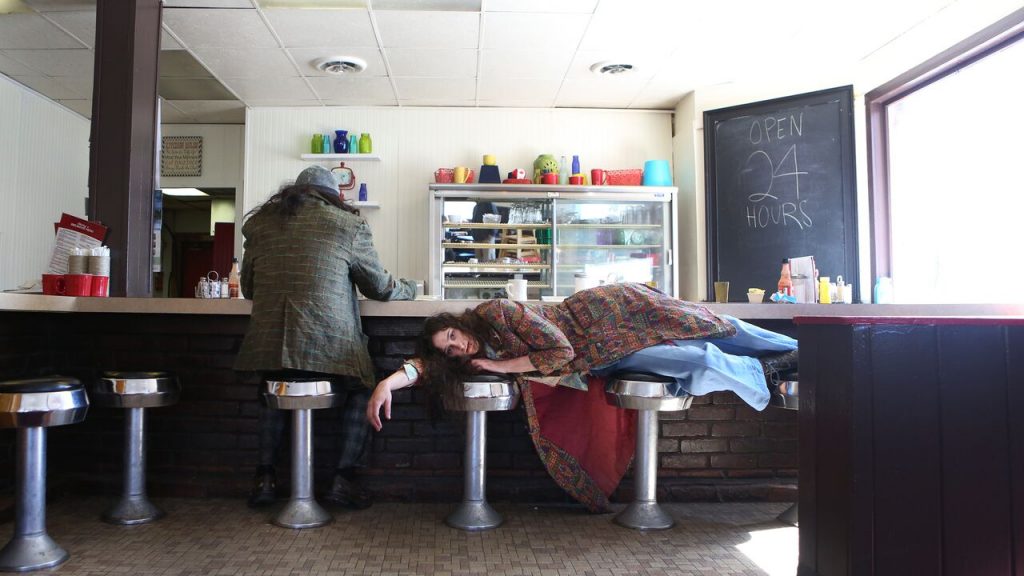By Kallan Dana

Josh Wagner ’17 and Lena Schwartz ’19 pose at local diner for Balm in Gilead poster shoot. Photo: Sue Kessler
When a large group speaks simultaneously, it’s difficult to catch each word of any individual. You may fixate on one person for a while, but not understand her. More likely, you’ll shift your focus from person to person, picking up information from small clues—the volume at which someone speaks, how quickly she moves (if she moves at all), where she directs her gaze. People-watching allows us to witness how one person uniquely inhabits the space around her, and how she coexists with others. Lanford Wilson’s Balm in Gilead puts a group of twenty-five people under a microscope and gives its audience the perverse pleasure of examining how this cluster of personalities forms, as actor Nick Leonard ’20 put well, a “f*cked-up, cohesive unit.”
Leonard’s choice of adjectives encapsulates the mood of Balm in Gilead’s world. Many of these characters are at their most dismal points during the action of the show due to their criminal activities, their addictions, their mental illnesses, or some combination of the three. The seedy, ‘70s New York diner in which most of the play takes place becomes a petri dish for the company to grow and evolve—or, rather, devolve. Lena Schwartz ’19 views her character’s arc in the play as a sort of foreboding regression. Schwartz suggests that her character, Babe, a severe heroin addict who spends much of the action disconnected from others and slumped in one corner of the bar, is “probably at the lowest point of anyone else in the show, and is probably a lot of the characters’ future.”

Schwartz ’19 slumped over counter. Photo: Sue Kessler
Lanford Wilson’s play strives to make its setting authentic, which means that the sprawling cast’s dialogue overlaps and interrupts, mimicking the loud, cluttered atmosphere a grimy, 24-hour restaurant would have. This tone presents a challenge to the actors, who must fully inhabit their characters, even when there is little to no text from which they may glean character traits. Anabel Milton ’18 remarked that her character’s description, “Kay: a waitress,” was particularly terse. Milton is not alone here; with a few exceptions, most of the characters have little text describing them. While this presents obstacles, the actors I spoke with expressed their enjoyment in having so much creative freedom in developing their personas. Josh Wagner ’17 indicated that the lack of character details gave him a “lot of room to work,” and Sadiq Ahmed ’20 emphasized how much he “goes off [his] instincts” when acting his part, Tig. Moreover, Ahmed stressed that discovering his character is a “continuous process,” and that every day in rehearsal he “finds tweaks and twitches to the character to add or take out.”
Kirsten Mulrenan ’18 also described her creative process as fluid and adaptable, saying that her perception of her character, Bonnie, has shifted since beginning. Recently, she’s began to feel that Bonnie has a “lot more of an interest in people” than she had initially believed. Mulrenan came to this conclusion mostly from having the freedom to explore and make choices in the rehearsal space, something which all the actors highlighted as a particular gift of this production. “There are limitations, but there’s a whole lot of freedom to screw around and improv our way through it,” Mulrenan explained.
This freedom provides difficulties as well. As Matt Clyne ’20 notes, it’s important to “recognize when you are allowed to use the freedom you’ve been given.” The show is a balancing act, and each actor must navigate when they can “do something to be noticed, or when they need to be more still,” Clyne adds. Many of the actors have found their natural habits and behavior onstage by establishing what characters they interact with most often, and in what capacity they do so. Milton likens her waitress character to a mother-like figure, “[treating] every customer like another kid coming into the daycare center.” Ahmed, on the other hand, has found that his character likes to “feel on top of everyone else,” a trait he’s uncovered just by being in the rehearsal space and seeing the people to whom he gravitates.
Consistently, actors focused on the realism of the show as developing out of the authenticity of the group dynamic. Leonard suggested that “a lot of the show exists in how the characters relate to each other…in our listening or pretending not to listen to each other.” I sat in on one rehearsal of Balm, in which they drilled one short scene, maybe just five minutes in length, over and over again. Each time they ran through it, I focused on a new character. They could have repeated the scene for another hour, and I still would not have noticed every detail. Every person onstage is living her own saga, in which she is the star and everyone else plays supporting roles. This form works only when the actors are focused, generous, and know their characters fully.

Wagner ’17 and Schwartz ’19 sprawled across diner seating. Photo: Sue Kessler
These characters are not required to be likable, but they must be real. You can fake likeability, but you can’t fabricate realness. Each actor in Balm in Gilead has worked to develop truthfulness in her portrayal, even if, in doing so, she has developed a character with some unseemly qualities. Even so, all the actors revealed love and fidelity to their parts. Milton chuckled that her character is a “badass,” and Wagner offered a thoughtful explanation for his role’s heroin addiction, explaining at length how painful it feels to undergo withdrawal. The actors have put in the extensive work to understand their characters, and it shows. One could likely watch the show every night of its run and have a radically different experience each time, because, as Mulrenan said, “these are all people, and these are just a couple days in their lives…it’s just about watching people existing.” At the heart of it, that’s what the formidable actors in Balm in Gilead have striven to do: exist as honestly as possible.
Balm in Gilead runs on the JKB Mainstage from Friday April 14th-Saturday April 15th, and Wednesday April 19th-Sunday April 23rd. All performances are at 8:00pm except for Saturday the 22nd at 7:00pm and Sunday matinee at 2:00pm. For ticketing information, click here.
***
Kallan Dana ’19 is an English/Theater double major and Staff Writer for the Living Newsletter.
